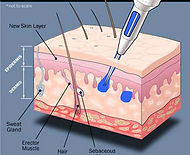

Tattoo Artist


By: Alexis Jendrasiak Bailey
About
History of tattoos go further back than bikers and rack stars. Ancient Maori tribes of new Zealand tattooed the faces of their warriors. The more tattoo ink you had on your face the higher yu are up in the social hierarchy. Then there is the anchor tattoo, which is the traditional mark of sailors who had crossed the atlantic ocean. Today, peole from all over get tattoos,in numerous styles and colors.. They rely on the talent and steady hands of tattoo artists to apply this permanent artwork to their bodies.
To create a tattoo, a tattoo artist first consults a client about the type and color of tattoo they want. Then the artist examines the area of skin wher the tattoo will be drawn to see if there are any abnormalities. If there are flaws of the skin, such as cuts or rashes, the tattoo will not be done. If the skin is flawless, the tattoo artist washes it with soap and water, shaves the area with a disposabe razor, applies an antiseptic, and then sketches an outline of the image to use as a guide. The images are often choosen from flash sheets, which are small cards of tattoo designs that are hung on the walls of tattoo studios. Before the actual tattooing begins be sure to apply a bit of ointment on the skin.
The artist uses a tattooing pen, to create the tattoo. This pen holds high speed, vibrating needles that inject ink under the skin. The pen can contain a singkle needle, or several. The needle must be sterilized before use so that no diseases are transferred to the client. To make thin lines, a single needle is used, to make thick lines or fill in spaces with color you would use a row of needles.
As the needle punctures the skin, little drops of blood may appear, but the artist will wipe away the blood periodically an continues working. When the artist is done, they will wash the tattoo area with watter and mild soap, covers it with an antiseptic ointment to avoid infections, and then finally applies a bandage.
Even though a tattoo artist does everything required to properly sterilize their equpiment, the client still faces the risk of becoming infected. To lower the risk, the artist gives the customer detailed instructions on how to look after the tattoo, and how to recognize thye signs of having an infection.
Small tattos can be done in under an a hour, while larger tattoos and more complex designs can take several hours. very large tattoos may take several sessions to complete.


